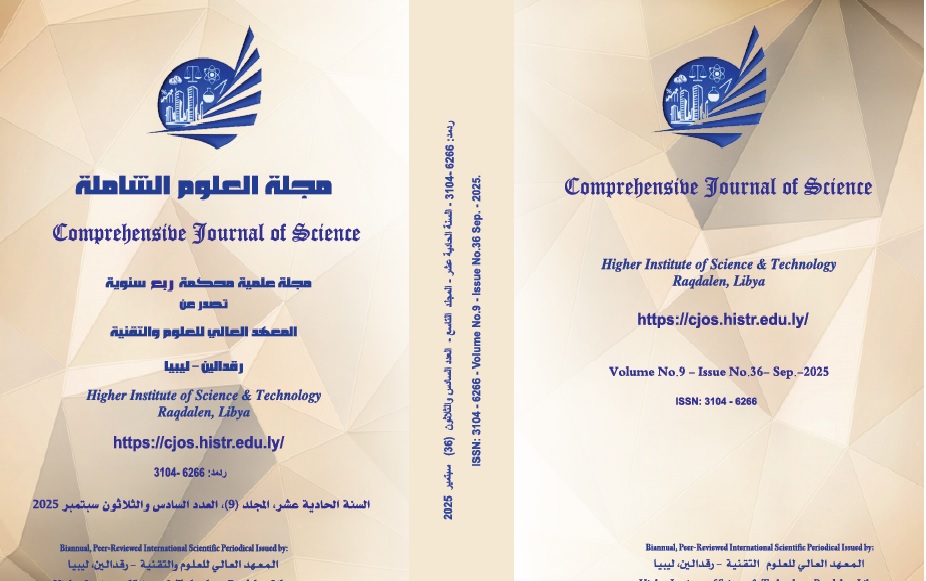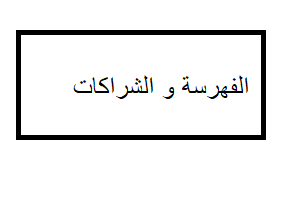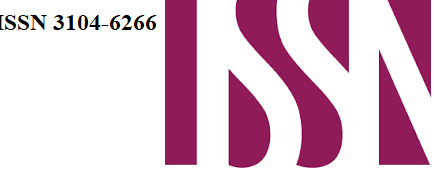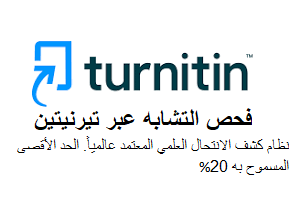دراسة مرجعية عن تأثير دورات الجفاف والرطوبه على تلف الخرسانة المعرضة لكبريتات الصوديوم
الكلمات المفتاحية:
كبريتات الصوديوم,دورات الجفاف-الرطوبة,التأكل،هجوم الكبريتات.الملخص
تعد مشكلة تلف الخرسانة بسبب التفاعل مع كبريتات الصوديوم من القضايا الهامة في الهندسة الإنشائية، خاصة في المناطق التي تتعرض لتقلبات مناخية حادة، يعتبر تأثير دورات الجفاف والرطوبة من العوامل الرئيسية التي تسهم في زيادة تأثير هذا التفاعل، حيث تتسبب هذه الدورات في تشققات داخل الخرسانة نتيجة للتغيرات المستمرة في حجمها بسبب التمدد والانكماش الناتج عن امتصاص الماء وتبخره، حيث تتفاعل كبريتات الصوديوم مع هيدروكسيد الكالسيوم في الخرسانة مكونًا هيدرات الكبريتات؛ مما يؤدي إلى زيادة حجم المادة المنتجة وتسبب في تمدد الخرسانة وتشققاتها، هذا التفاعل يصبح أكثر حدة في ظروف دورات الجفاف والرطوبة؛ حيث أن هذه الدورات تسهل امتصاص الماء مرة أخرى في الخرسانة، مما يعزز التفاعل مع كبريتات الصوديوم ويزيد من تدهور الخرسانة.
تهدف هذه الدراسة المرجعية الى دراسة تأثير العوامل البيئية مثل التغيرات بين الجفاف والرطوبة على متانة الخرسانة، بالإضافة إلى تأثير تفاعل الخرسانة مع كبريتات الصوديوم،حيث يمكن أن تتفاعل مع مكونات الخرسانة، مما يؤدي إلى تدهورها أو تآكلها. تكمن أهمية هذا في فهم كيفية تأثير كبريتات الصوديوم على الهيكل الخرسانى، خاصة في البيئات التي تحتوي على تركيزات عالية من كبريتات الصوديوم.
خلصت الدراسة إلى أن استخدام مواد وتقنيات معززة للمتانة يمكن أن يساعد في تقليل تأثيرات تفاعل كبريتات الصوديوم وضمان استدامة الخرسانة في هذه البيئات،كالاستبدال الجزئي للاسمنت البورتلندي بالرماد المتطاير حيث يمكن للكمية المناسبة من الرماد المتطاير أن تحسن بشكل فعال البنية الداخلية للخرسانة لتقليل أضرار التآكل وخفض نسبة ماء الخلط يمكن أن تحسن من مقاومة الخرسانة لهجوم كبريتات الصوديوم كما أن زيادة فترة الدورة الجافة والرطبة تؤدي تدريجياً إلى زيادة عمق تأثير هجوم الكبريتات داخل الخرسانة، وبالتالي يجب أن يؤخذ في الاعتبار تأثير دورات الجفاف والرطوبة عند تصميم الهياكل الخرسانية في بيئات معرضة لتقلبات مناخية.
التنزيلات
المراجع
[1]. Liao, K.X.; Zhang, Y.P.; Zhang, W.P.; Wang, Y.; Zhang, R.L. )Modeling constitutive relationship of sulfate-attacked concrete(. Constr. Build. Mater،260. )2020(.
[2]. He, R.; Zheng, S.N.; Vincent, J.L.; Wang, Z.D.; Fang, J.H.; Shao, Y.( Damage mechanism and interfacial transition zone characteristics of concrete under sulfate erosion and Dry-Wet cycles). Constr. Build. Mater. 255. (2020).
[3]. Alyami, M.H.; Alrashidi, R.S.; Mosavi, H.; Almarshoud, M.A.; Riding, K.A. (Potential accelerated test methods for physical sulfate attack on concrete). Constr. Build. Mater. (2019), 229.
[4]. Rajamma, R.; Ball, R.J.; Tarelho, L.A.C.; Allen, G.C.; Labrincha, J.A.; Ferreira, V.M. (Characterisation and use of biomass fly ash in cement-based materials). J. Hazard. Mater., 172, 1049–1060. (2009)
[5]. M.T. Bassuoni et al.(Response of concrete to accelerated physical salt attack exposure) Cem. Concr. Res.(2016)
[6]. Cheng, S.K.; Shui, Z.H.; Gao, X.; Yu, R.; Sun, T.; Guo, C.; Huang, Y. (Degradation mechanisms of Portland cement mortar under seawater attack and drying-wetting cycles). Constr. Build. Mater. (2020)
[7]. Fang Liu, Zhanping You, Rui Xiong, Xu Yang, (Effects of Sodium Sulfate Attack on Concrete Incorporated with Drying-Wetting Cycles),(2021)
[8]. Chen, Y.; Liu, P.; Zhang, R.L.; Hu, Y.; Yu, Z.W. (Chemical kinetic analysis of the activation energy of diffusion coefficient of sulfate ion in concrete). Chem. Phys. Lett753,.(2020),.
[9]. Guan Y., Sun W., and Miao C., (One service-life prediction model for the concrete based on the reliability and damage theories I: narration and establishment of the model), Journal of the Chinese Ceramic Society29, no. 6, 509–513. (2001)
[10]. Cheng, Y.Z.; Dong, Y.; Diao, J.K.; Zhang, G.Y.; Chen, C.; Wu, D.X. MSWI (Bottom Ash Application to Resist Sulfate Attack on Concrete). Appl. Sci. 9, 5091 (2019).
[11]. Nehdi, M.L.; Suleiman, A.R.; Soliman, A.M. (Investigation of concrete exposed to dual sulfate attack). Cem. Concr. Res64, 42–53.(2014).
[12]. Cheng, S.K.; Shui, Z.H.; Gao, X.; Lu, J.X.; Sun, T.; Yu, R. (Degradation progress of Portland cement mortar under the coupled effects of multiple corrosive ions and drying-wetting cycles). Cem. Concr. Compos, 111.( 2020).
[13]. Neville, A. (The confused world of sulfate attack on concrete). Cem. Concr. Res. 34, 1275–1296. (2004)
[14]. Chen, H.C.; Huang, H.L.; Qian, C.X. (Study on the deterioration process of cement-based materials under sulfate attack and drying–wetting cycles). Struct. Concr. 19, 1225–1234.( 2018).
[15]. Wang, K.; Guo, J.J.; Wu, H.; Yang, L.( Influence of dry-wet ratio on properties and microstructure of concrete under sulfate attack). Constr. Build. Mater,263. (2020).
[16]. Ma, H.Y.; Gong, W.; Yu, H.F.; Sun, W. (Durability of concrete subjected to dry-wet cycles in various types of salt lake brines). Constr. Build. Mater 193, 286–294, (2018).
[17]. Sahmaran, M.; Erdem, T.K.; Yaman, I.O. (Sulfate resistance of plain and blended cements exposed to wetting-drying and heating-cooling environments). Constr. Build. Mater., 21, 1771–1778. (2006)
[18]. Guo, J.J.; Yang, M.; Chen, H.L.; Han, J.H. (Experimental study on fracture properties of modified concrete attacked by sulfate corrosion under dry-wet circulation). J. Hydraul. Eng. ASCE, 49, 419–427. (2018)
[19]. Ganjian, E.; Pouya, H.S. (The effect of Persian Gulf tidal zone exposure on durability of mixes containing silica fume and blast furnace slag). Constr. Build. Mater., 23, 644–652. (2008)
[20]. Yang, K.H.; Lim, H.S.; Kwon, S.J.( Effective Bio-Slime Coating Technique for Concrete Surfaces under Sulfate Attack). Materials , 13, 1512. (2020)
[21]. Liu, F.; You, Z.P.; Diab, A.; Liu, Z.Z.; Zhang, C.; Guo, S.C.( External sulfate attack on concrete under combined effects of flexural fatigue loading and drying-wetting cycles). Constr. Build. Mater. 249. (2020).
[22]. Pang, C.M.; Xu, J.; Wang, J.; Wang, L.; Qin, H.G.; Sun, W. (Investigation of the Process and Regime of Drying and Wetting of Concrete). Build. Mater. 16, 315–320,(2013).
[23]. Sutrisno, W.; Suprobo, P.; Wahyuni, E.; Iranata, D. (Experimental Test of Chloride Penetration in Reinforced Concrete Subjected to Wetting and Drying Cycle). Appl. Mech. Mater, 851, 846–851.( 2016)
[24]. Sobhan, K.; Gonzalez, L.; Reddy, D.V. (Durability of a pavement foundation made from recycled aggregate concrete subjected to cyclic wet dry exposure and fatigue loading). Mater. Struct., 49, 2271–2284. (2016)
[25]. Liu, R.D.; Zhang, J.W.; Liu, S.W.; Li, K.; Zhang, C.Y. (Effect of sulfate dry-wet circulation environment on concrete performance). Concrete, 4, 16. ( 2018)
[26]. Liu, Q.D.; Liu, R.G.; Jiang, H.; Teng, B.; Lu, C.H. (Artificial climate simulation acceleration test design of concrete structure in wet-dry cycling zone). Concrete, 11, 55–57. (2018)
[27]. Liu, J.Y.; Huang, Z.Y.; Zhu, J.H.; Liu, W.; Zhang, W.( Effect of Fly Ash as Cement Replacement on Chloride Diffusion, Chloride Binding Capacity, and Micro-Properties of Concrete in a Water Soaking Environment). Appl. Sci., 10, 6271, )2020(
[28]. GB/T 50082-2019. Standard for Test Method of Long-Term Performance and Durability of Ordinary Concrete; Chinese Standard Institution Press: Beijing, China, (2019).
[29]. ASTM C1012. Standard Test Method for Change of Hydraulic-Cement Mortars Exposed to a Sulfate Solution; ASTM International: West Conshohocken, PA, USA, (2010).
[30]. Scherer, G.W. (Stress from crystallization of salt). Cem. Concr. Res., 34, 1613–1624. (2004)
[31]. Guo, J.J.; Wang, K.; Guo, T.; Yang, Z.Y.; Zhang, P. (Effect of Dry-Wet Ratio on Properties of Concrete under Sulfate Attack. Materials), 12, 2755. (2019)
[32]. Zhang, H.; She, W. (A Modulus Variation Model of Concrete under External Sulfate Attack: New Perspective from Statistical Evolution of Microcracks). J. Wuhan Univ. Technol. Mater. Sci. Ed. , 33, 1465–1471. (2018)
[33]. Golewski, G.L. (Estimation of the optimum content of fly ash in concrete composite based on the analysis of fracture toughness tests using various measuring systems). Constr. Build. Mater, 213, 142–155.( 2019)
[34]. Jin-Jun Guo ,Peng-Qiang Liu, Cun-Liang Wu,Kun Wang, (Effect of Dry–Wet Cycle Periods on Properties of Concrete under Sulfate Attack),(2021).
[35]. S. Zhutovsky .(Accelerated testing of cementitious materials for resistance to physical sulfate attack) Constr. Build. Mater.(2017)
[36]. G. Massaad .(Advanced testing and performance specifications for the cementitious materials under external sulfate attacks)Constr. Build. Mater.(2016)
[37]. R.J. Flatt (Salt damage in porous materials: how high supersaturations are generated) J. Cryst. Growth(2002)
[38]. B.Y. Lee .(Effect of pore structure on salt crystallization damage of cement-based materials): Consideration of w/b and nanoparticle useCem. Concr. Res.(2017)
[39]. T. Stryszewska .(The effects of salt crystallization in ceramic bricks in terms of line deformations Procedia Eng).(2017)
[40]. Z. Liu .Does (concrete suffer sulfate salt weathering) Constr. Build. Mater.(2014)
[41]. Z. Liu .The role of Ca(OH) 2 in sulfate salt weathering of ordinary concreteConstr. Build. Mater.(2016)
[42]. Z. Lafhaj .Correlation between porosity, permeability and ultrasonic parameters of mortar with variable water/cement ratio and water contentCem. Concr. Res.(2006)
[43]. M.T. Bassuoni .(Durability of self-consolidating concrete to sulfate attack under combined cyclic environments and flexural loading) Cem. Concr. Res.(2009)
[44]. L. Josserand .(Bleeding of concrete as an ageing consolidation process)Cem. Concr. Res.(2006)
[45]. İ.B. Topçu .(Influence of concrete properties on bleeding and evaporation) Cem. Concr. Res.(2004)
[46]. ACI Committee 201, Guide to durable concrete, American Concrete Institute, Farmington Hills.
[47]. R.J. Flatt .(A commented translation of the paper by C.W. Correns and W. Steinborn on crystallization pressureEnviron). Geol.(2006)
[48]. T.P. Dolen .(Effects of Concrete Deterioration on Safety of Dams), Department of the Interior Bureau of Reclamation(2003)
[49]. Ragoug, R.; Metalssi, O.O.; Barberon, F.; Torrenti, J.M.; Roussel, N.; Divet, L.; de Lacaillerie, J.B.D. (Durability of cement pastes exposed to external sulfate attack and leaching: Physical and chemical aspects). Cem. Concr. Res, 116, 134–145, (2019).
[50]. Suleiman, A.R.; Soliman, A.M.; Nehdi, M.L. (Effect of surface treatment on durability of concrete exposed to physical sulfate attack). Constr. Build. Mater., 73, 674–681. (2014)
[51]. A Hu,H Xu,J Ye,M Yan,L Zhang,B Zhang,C li,(mplug-docowl 1.5;unified structure learning for ocr-free document understanding),2024.
[52]. S Yan,Z Yang,H Li,C Song,L Guan,H Kang,G Hua,(implicit autoencoder for point-cloud self-supervised representation learning),2023.
[53]. Jin jun Guo,peng,cun,wang,(Effect of dry-wet cycle Periods on properties of concret under sulfat attack),2021.
[54]. Santhanam,(proposed mechanism of sodium sulphate attack),2002
التنزيلات
منشور
إصدار
القسم
الرخصة

هذا العمل مرخص بموجب Creative Commons Attribution-NonCommercial-ShareAlike 4.0 International License.










